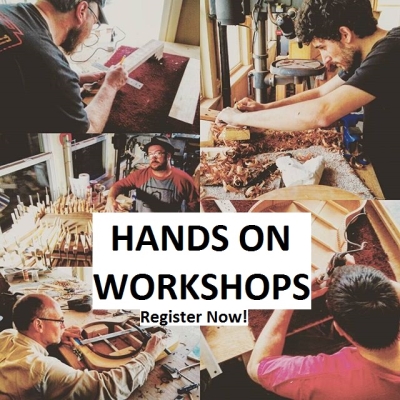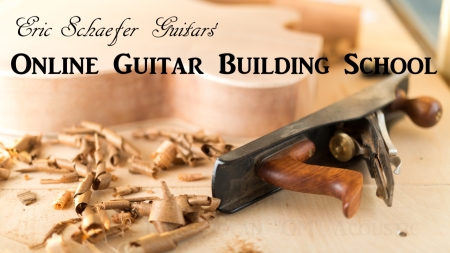 Eric Schaefer Guitars’ Online Guitar Building School
Eric Schaefer Guitars’ Online Guitar Building School
This is a free video from the “Building an OM Acoustic” Course. Click here for more free video tutorials.
Lesson Transcript:
The shooting board is a jig used in conjunction with a handplane to square up stock.
The workpiece rests on the upper shelf against the backstop while a handplane rides along the lower shelf.
A sanding stick can also be used instead of the handplane.
First, the upper shelf is attached to the lower shelf.
Then the backstop is attached to the upper shelf.
And finally, a batten is attached to the underside of the jig so that the jig can be held steady against the workbench.
I also add a toggle clamp for securing the workpiece to the upper shelf.
Okay, now that we understand the basic steps, lets get started:
Okay so now we are going to build ourselves a shooting board. This here is a shooting board. It is a little bit of an extra long shooting board. That’s because a lot of the things that we will be working with; the sides, the neck, tend to be longer pieces.
So, it is a little helpful for an instrument maker to have a shooting board with that extra length.
In total this is 36″ in length.
So let’s take a look at the parts I already have cut up right here for this.
This is the base platform.
I cut this to the dimensions of 14.5″ X 36″.
And then this is going to go right over top.
This is 10″ by 36″.
This is our backstop. 2″ X 10″.
And underneath we are going to have a 2″ X 14.5″batten screwed to the bottom.
It helps you to secure the jig in place when you are using it, so we’ll screw that to there and then when we are using the jig and putting forward pressure on it with out handplane, it’s not going to continue tp push forward and slide on us. This batten on the bottom will help hold it in place.
This is 3/4″ plywood or particle board.
You can use plywood. You can use MDF. MDF is always really great. It holds up really well to changes in humidity and things like that. Particle board works fine though. It is cheap. So we’re going to use that.
Okay, so let’s get started.
The first step is to drill pilot holes for the screws. I am using 1 1/4″ screws. About 2″ from the edge on each side, I make marks for my screw locations and then drill. Each screw is about 6″ apart.
I put a clamp on one end and for the other end, beacuse I don’t have a clamp that reaches back there, I am going to put a weight on it. That is just to hold it in alignment while I drill these holes.
Now I use a countersink bit so that the screws will sit below the surface of the jig.
Apply wood glue and screw in place.
So while that is curing, we can keep working on this. I do want to clean up any squeeze out that comes out along this edge, though.
Okay, next we want to screw down the backstop. That is our 2″ by 10″ piece. I am going to add this nifty toggle clamp but you don’t have to.
I got by for years without this thing, but now I really like having this on the jig so you can clamp down whatever you are working on.
I just want to mark this off; where it’s going to be on our 2″ by 10″ piece, so that I don’t put a screw beneath it where these screws are supposed to go.
Drill 4 pilot holes. Apply glue. And screw in place.
Now I am going to add the batten to the bottom.
Here’s our 2″ by 14.5″.
It is going to be 11″ up from this end.
So let’s measure that out.
Okay, so this is going to go right on that line.
Now we can drill our pilot holes.
I’m not too concerned with where these pilot holes are; just two on this side, two on that side.
Was this useful? I would love to hear your questions or comments! I try to answer every e-mail I receive, so please be patient with me ![]() eric@ericschaeferguitars.com
eric@ericschaeferguitars.com
Want more of this? Subscribe below for Weekly Guitar Making Tips on “The Small Shop Luthier Blog”
Want to learn more? Take a class with Eric Schaefer and build your own guitar in 8 days


